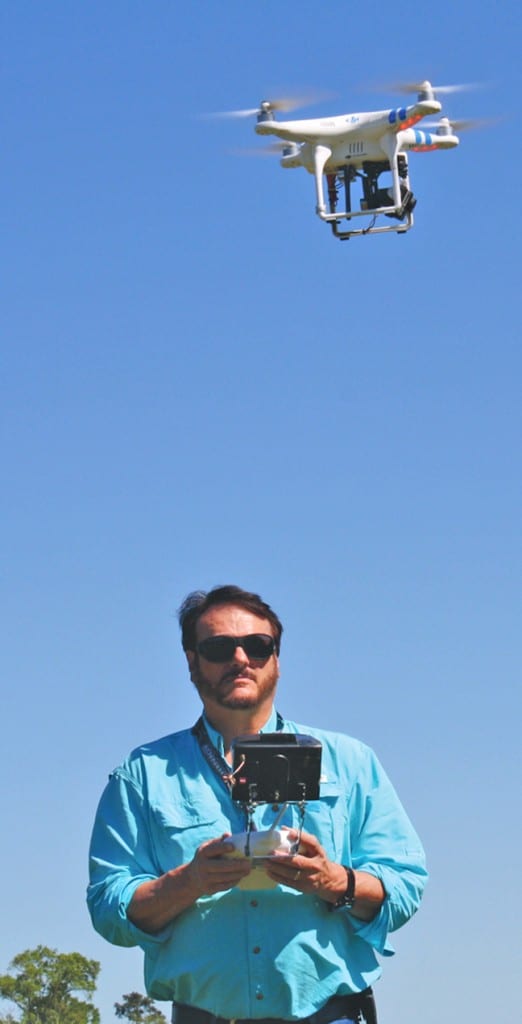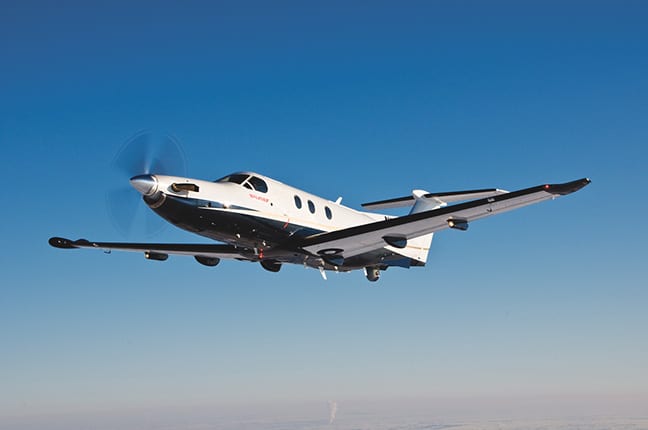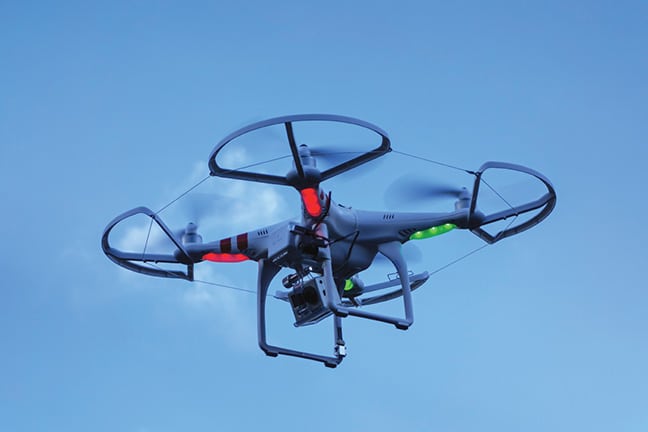Sure, They Have Many Useful Applications.
But What About Those Recent Industry Flyovers?

Maurice Fontenot with Bayou Country Outdoors TV Show, is shown flying their DJI Camera Drone Helicopter. Photo by Susan Melton, also of Bayou Country Outdoors TV Show.
You may have noticed a brief crime report that was published a few weeks ago in the American Press. The short story stated that an unidentified drone was reported to have been “seen flying over local industrial plants.”
“Anyone with information” about the mysterious drone was asked to call something called the Joint Terrorism Task Force. A phone number was given.
I called that number shortly after lunch time one day. When my call was answered, I told the person on the other end of the line I was hoping to write a story about the drone problem for Lagniappe, and wondered if he could pass on any information about the matter it would be helpful for the public to know.
He told me he was working with the FBI and that the FBI wouldn’t be issuing any statements about the matter.
Well, you’re not going to argue with the FBI, of course. But the response left me a little curious as to why the phone number had been printed in the newspaper in the first place. After all, I’d started by offering to pass on helpful information to the public.
I was further told that any information on the drone matter would have to come to me via Kim Myers (public affairs officer for the Calcasieu Parish Sheriff’s Office) and would have to be approved by the Sheriff’s Office.
This didn’t exactly sound like a warm and cozy invitation to communicate either. But I did my reporterly duty and called Myers and left a message on her voice mail. 
But, of course, I was making other calls as well. One local drone owner, who uses drones to do aerial work for local industries that request it, told me he had been contacted by the FBI the night before I called him.
I also called a state expert on drone law whose name I’d been given by a local photographer. He told me (again, to my surprise) that he could not talk with me at all about the matter because he was now working with the FBI on it. “They got to me first,” he said.

Williams related this story: a drone in the form of an airplane (not a “quad copter”) came in low over the water towards a local industrial plant. The drone’s colors were gray and white; the wing span roughly 8 feet. After making several course corrections, it took a three-second flight over the plant, after which, it flew away to the northeast.
Many locals say they have seen multiple flights over local industry in the past month.

In addition to the obvious concern about threats to industrial secrecy, there are, in this case, concerns about potential damage. Williams said that drone planes such as the one in question can travel as fast as 40 mph. Who knows what sort of damage might have occurred if any of the course corrections had been off.
It’s obviously a paradox that when corporate bureaucrats become too sensitive about secrecy, they make it difficult, if not impossible, for the public to give them the information they need to move forward. And it’s ironic that a cautious style of dealing with plant secrecy is at the heart of the local drone story. For the current drone story, all over the country, is mainly about one thing — secrecy.
If the public is given no information about a local drone situation but is asked to offer up information about it, then the public can do little more than imagine what might have been behind the drone flight in industrial SWLA.
Of course, it could have been a case of industrial spying. It could, possibly, have been a test of experimental drones by either private interests or the U.S. government. It could have been an elaborate prank by an especially gifted teenager hacker; likewise, it could have been an elaborate prank arranged at great effort by a disgruntled employee or executive. And, of course, in the worst-case scenario, it could have been an information-gathering exercise by some homegrown terrorist contemplating an act of industrial sabotage.
The FAA WEIGHS IN
The very brief American Press story about the incident stated that Louisiana law stipulates that “it’s illegal to fly drones over industrial plants without plant owners’ permission.” But the reported fees for doing this — “$500 and as many as six months in jail” — would hardly be likely to deter a zealous would-be terrorist.
Louisiana’s laws about drone flight are downright draconian compared to the long-anticipated rules for drones proposed by the FAA on Feb. 14.
According to the proposed new FAA rules, a commercial drone must be:
— Flown within the flyer’s eyesight.
— Flown below a height of 500 feet.
— Flown (that is, guided) by someone who has a special “UAS operator certificate,” which is expected to cost less than $300.
Small drones will be largely exempt from having to meet standards for airworthiness. Drones that weigh under 4.4 pounds will be governed by even looser airworthiness standards.
If you think these rules are a tad loose, you aren’t alone. The FAA earlier sent a different set of rules to the White House. Among these, reported the Wall Street Journal, were rules that would “limit flights to daylight hours” made “below 400 feet.”
The White House, which wishes to encourage drone flight, sent that set of rules back to the FAA, asking for more liberal regulations.
You still have until April 24 to comment on the FAA regulations if anything about them displeases you.
It shouldn’t come as a shock that the White House supports drone flight, given that President Obama has been sending drones into Pakistan since day one in controversial military actions that have been the source of much unrest and political upheaval in that country.
But that is the very tip of the iceberg. The U.S. Air Force is now flying the fleet of its two types of drones — Reaper and Predator — 350,000 hours each year.
There have been frequent reports of Air Force drone crashes in Syria, Yemen and Afghanistan. ISIS recently posted a video of what it said was a crashed U.S. drone. The Times reported that “U.S. officials” confirmed that the drone in the video was a U.S. Predator.
In 2014, the U.S. Air Force itself reported 14 crashes of drones in foreign countries.
According to a New York Times report of March 25, the Air Force is also launching drones from the countries of Turkey, Italy, Ethiopia, Kuwait, Qatar, the United Arab Emirates and Djibouti. In addition, says the Times, the CIA runs drone bases in Saudi Arabia and Afghanistan.
It’s clear the U.S. government is doing something with drones, and doing it for 1,000 hours each day. Given those facts, it suddenly seems not so far-fetched that the government might feel that it has reasons to scope out major domestic pertrochemical operations — and especially any that might be seen as having possible defense applications.
The Privacy Problem
What government officials can do, citizens can do — albeit on a much, much smaller scale. Recent Russian news reports of the fighting in Ukraine have been proven false when Ukrainian citizens have launched drones over battlefields and released recordings of the actual battle situations.
Amateur and professional operators of drones are disproportionately intelligent and tech-savvy people. They are able to figure out how to use the photography, observation and surveillance advantages of drones.
What are the advantages? Slate writer Margot Kaminski (“The Rules of the Sky privacy protections still aren’t adequate”) says that drones are “far lower-cost than older aerial technologies, and they can move over boundaries that otherwise protect activity from sight.”
She goes on to say, “these are only a few reasons why drones have been predicted to be a ‘privacy catalyst’ — the drivers of robust discussions about the enactment of new privacy regulations.”
Don’t expect those privacy regulations to come from the FAA. The FAA’s job is to ensure aircraft safety. It has no concern with personal privacy.
This message was conveyed quite clearly to the Electronic Privacy Information Center, when it petitioned the FAA to keep privacy issues in mind as it created its drone rules.
Faine Greenwood, of the New America Foundation, is one of the country’s lead drone experts, as well as a drone flyer and photographer herself. In a recent article for the drone industry magazine uUAS news, which bore the powerful title “Drones, The Surveillance Equalizer,” Greenwood states that “the public’s biggest worry about drones [is that] they can, potentially, be used to spy on everyday citizens.”
The Citizen’s Opportunity
What Greenwood does in her article is look at the flip side of that fear. “With the advent of inexpensive UAVs [drones],” she writes, “average citizens can for the first time in history keep tabs on illicit or criminal behavior by the government, corporations and other powerful entities.”
Civilians who have privacy concerns should, says Greenwood, “step back and realize that drones will likely be one of the most effective tools they have at their own disposal, for countering government and private abuses and corruption.”
She goes on to say citizens will be perfectly capable of catching well-known neighborhood criminals in the act with convincing drone videos and photographs.
Suppose you have no such heady notions about drones. Suppose you just want to fly drones for the reasons Greenwood does — for your personal amusement and edification.
Here are a few ideas about how to proceed.
The nitty gritty of drone rules has yet to be clarified in court battles. Until it is, follow FAA guidelines and keep your drone under 500 feet. By all means, do not fly over 500 feet then post a video of your flight on YouTube.
If you use a drone to take photos or make films, think carefully about charging money for these items. Once you charge for them, you are operating a commercial drone, not a hobby drone. The few drone operators who have been warned by the FAA have been commercial drone operators. If you have concerns about any possible risks of operating a commercial drone venture, consult with an attorney.
Obviously, don’t fly a drone over a property unless you have the owner’s permission; get it in writing.
‘There’s A Lot Of Those Things Around’
Any way you cut it, drone technology is off the hook. In his work, local drone professional Maurice Fontenot uses a drone that’s positioned by seven GPS satellites. “I can park it in the air,” he says. He sometimes uses it for imagery that appears in his long-time local and national television program Bayou Country Outdoors.
It’s not just technological innovation that’s driving the drone phenomenon. It’s also the size of the thing. Fontenot says he knows four other drone owners in this area, one of whom does “inspections at the plants” with drones.
As the drone enterprise grows, it will become ever more difficult to track down the origins of any given drone flight. “There’s a lot of those things around,” says Fontenot.
Add it all together, and the drone phenomenon is a runaway train of technology, surveillance, commerce and personal amusement. The best and the brightest push it a little further forward every day. If regulators want to have a say-so in the future development of drone use, they’d better get serious about figuring out how to slow down the runaway train.
















Comments are closed.